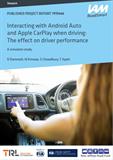Infotainment - The Impact of interacting with Android Auto and Apple CarPlay when driving
During the study, drivers completed a series of three drives on the same simulated test route to assess the level of impact from infotainment systems (Android Auto and Apple CarPlay as examples). On the first run, drivers did not interact with the system. On subsequent runs, drivers interacted with the system using voice control only and then using touch control only.
Both methods of control were found to significantly distract drivers however, touchscreen control proved to be the more distracting of the two. While many drivers realised the system was causing a distraction and modified their behaviour such as slowing down, performance was still impacted with drivers unable to maintain a constant distance to the vehicle in front, reacting more slowly to sudden occurrences and deviating outside of their lane.
The study also found that using touch control resulted in reaction times that were even worse than texting while driving and drivers would often underestimate just how much their eyes were off the road while using touch control. Touch control also caused drivers to take their eyes off the road for longer than the NHTSA (National Highway Traffic Safety Administration) recommended guidelines.
Many of the participants also found that controlling the car’s lane position as well as keeping a consistent speed headway to the vehicle in front suffered significantly when interacting with their infotainment systems, particularly when using touch control.
While the research does suggest that current systems are performing on a much higher level than they were a few years ago thanks to technological advances, it’s proving to still be a distraction for many drivers and anything that distracts a driver’s eye is estimated as a factor for as many as 30% of all road collisions in Europe each year.
This is why IAM RoadSmart has called on the industry and government to openly test and approve these systems to an agreed standard before they are released.
Read the full report here.

